Finding the Fuses
Note that several hundred volts are present on the surrounding boards below. See the caution at the beginning of this article. Do not attempt to test fuses with the power on if you are not qualified. Do not attempt to replace fuses with the power on. The voltages present are potentially lethal.
The first step to doing any type of pinball machine maintenance is to open the cabinet. Prior to starting, make certain there is enough room in front of the machine equal to the length of playfield glass, so it can be pulled all the way out and safely removed.
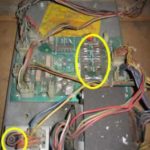
1) Open the lower front coin door. This is the door where the coins would be inserted. Usually, it is locked and you will need the key.
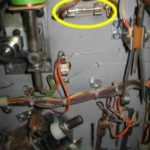
2) Look for the lockdown lever to the right of the open door (see opening the pinball machine). This holds down the lockdown bar which is at the bottom of the playfield glass.
[Note: Click on the photo for a larger image.]
On the photo to the left are the fuses located on the power supply board for a early Bally SS pinball machine. These are located behind the backglass behind a protective metal cage to protect from the shock hazard (later Bally pins have this circuit board and fuses below the playfield).

Note in this photo, some prior owner soldered the wires directly to the plug pins rather than replacing a charred plug. This author replaced all the plugs and pins to get this working. I would not trust having the correct fuses installed on this one.
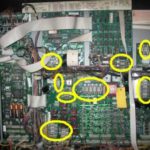
On the picture to the right, these are the fuses located in a Bally / Williams game from the early 90’s. These are located in the backbox, behind the translite (picture).
Testing Fuses
Resistance with a DVM
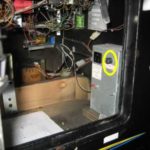
Many people think that fuses always blow violently. They look for a burn mark, char, or an obviously broken wire. Absence of those signs means a fuse is good, right?! Nothing could be further from the truth. I have had owners pull out fuses and pronounce them as good. A careful look might reveal a subtle break in the wire, but I have seen fuses that look perfect yet they are blown. The only way to be certain that a fuse is good is to test it with a voltmeter.
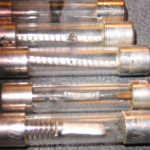
In the photo to the right, all the fuses are blown. The top one is what most people expect to see. The center one is fairly subtle. Follow the wire that is twisted around the white material and in the center, it is broken (click on the photo for a larger image). If that fuse is in its holder and that part of the wire is hidden, you will never see it!
It is not unusual for the blown part of the fuse to be hidden underneath the metal caps on either end making it impossible to see the defect.

This setup is testing the fuse for resistance. A good fuse will test almost zero resistance (to the limit of the voltmeter). For illustration, this shows testing with the fuse removed from the game. The easiest way to test is to just remove one end of the fuse from the clip fuse holder on the circuit board. Leave the other end in place, holding the fuse. Then check the resistance.
It is impossible to check the fuse while it is in place because other parts of the circuit may cause a false good reading. The fuse has to be removed (at least one end) from the holder.
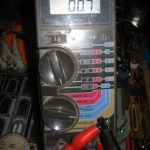
The safest way to test a fuse is to remove at least one end (or remove it entirely) and then test the resistance with a digital volt ohm meter (DVM). Prior to running the test, set up the volt meter to resistance. Then move the value to the lowest possible setting. Check to see that it is operating by connecting the two leads together. The fuse should read close to this value. It will never read zero (at this most sensitive setting) as the wires and plugs contribute some resistance.
Connect the leads to each end of the fuse, as shown on the left side. Any reading close to what you got connecting the two leads together means the fuse is good. A blown fuse will read almost infinite.
Checking Voltage
We have recently come across slo blo (slow blow) fuses that test good in the resistance test, but do not work properly (they do not pass current). There are two ways to check for this:
- Put in another slo blo fuse and see if it fixes the problem.
- Measure the voltage drop across the fuse. Or measure the voltage on each side of the fuse separately.
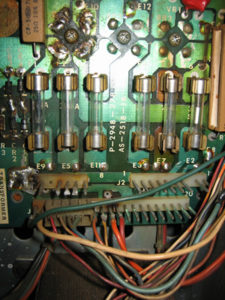

#1 risks blowing another fuse out, if the problem is in the circuit. #2 is a better answer, but it involves the using a DVM with the power on – something which is best left to qualified personnel – see caution on the home page.
Note that this test is only needed on slo blo fuses.
To perform this test on an early Bally SS, set your DVM to AC (these fuses are in the AC side of the circuit) and connect a lead to each side of the fuse. The reading should be almost zero. If it is more than a small fraction of a volt or few mv (normal due to some resistance), then turn it off and replace the fuse.
Do not attempt to perform this test on the main fuse which is sealed in the black cylinder on most games.
Replacing the Fuse

The quickest way to destroy your expensive pinball machine, start a fire, and perhaps burn down your house, is to put the wrong value fuse in the pinball machine. If you do not have an exact replacement, do not put in a substitute. Just as important, while you are at it, check the fuses in your machine and make certain the correct ones are in there. The majority of pinball machines I own had fuses of too high a value placed in there by some person who did not care enough to be safe.
There is usually a chart in the backbox of the fuse locations and the values. Typically, in tiny letters on the metal part of a fuse will be the value of that one. Make certain that they match. A 8A fuse in place of a 2A is just asking for tragedy (destroy the circuit board and a fire). Don’t even try a larger value as a test, you are just asking for trouble.
The most important value to match is the current rating of the fuse (amperage = A). Voltage is generally not important as most fuses are rated at 250V and the voltage application here is much lower – usually 6 V up to about 75 V. It is always OK to use a fuse rated at a higher voltage, but NEVER a higher current (amperage = A). It is NOT OK to use a low voltage rated fuse in a high voltage application.
There are different categories of fuses, too: Fast Blow vs. Slow Blow. These titles are self explanatory as a Fast Blow (FB) fuse will blow as soon as the current exceeds the rated value, while a Slow Blow (SB or slo blo) will allow current to exceed the fuse rating for a short period of time. Since most electronics has a rush of higher current when it is first turned on, many of the fuses are Slow Blow (Slo Blo or SB). Unfortunately, there is not a lot of standardization as to labeling with fuses, but a Slow Blow (SB) fuse is usually labeled as MDL. A Fast Blow (FB) fuse is usually labeled AGC. Fuses that have a wire wrapped around something else are usually (emphasis – USUALLY) SB. A fuse that is just a simple single wire is usually FB. Sometimes a fuse can have a single wire with little drips of what look like solder on them. Those are sometimes part way in between SB and FB fuses and are usually not seen in pinball.
If a FB fuse is used where a SB is needed, usually that fuse will fail. If a SB fuse is used where a FB is required, it is almost as dangerous as using too high a current fuse. Circuit board damage, a fire, or worse could result. More information about fuses.
I Replaced the Fuse – Now What?
A fuse can blow for either of two reasons:
1) The fuse just randomly fails and replacing it fixes the problem. I refer to this as the “fuse just feels like blowing” scenario. This would be the best outcome.
2) Something else is wrong. When the fuse is replaced, the new one blows again. That indicates that something else is wrong and it is usually serious. Frequently, this means a bridge rectifier or a transistor has shorted. Fixing this requires an electronics technician and is beyond the scope of this website (see all those precautions). If the fuse stays until a coil / solenoid is activated, then it can be that the coil is defective or the diode across the coil is shorted.
Know your limitations. You have a valuable piece of equipment. Don’t take the chance with your pinball machine, your life, or your belongings and try to fix something you are not qualified to do.
Comments
Comments, including suggestions, improvements, errors, etc. are welcome (see below).
If you have a specific question about your game that does not directly apply to this page, please see our FAQ section.
Copyright 2006 – 2020, all rights reserved.
My friend has pinball machines.I want to learn how to maintain them. I am an old school electrician, electronics guy. How do I get started? Need a new hobby!
This is a good place to start. Since you already know how to solder and use a voltmeter, you are half way there.
We suggest starting under the ‘Basic Stuff’ menu and start skimming. Much of that might be too basic for you, but if you are not at all familiar with pinball, parts maybe useful.
There are two types of pinball machines, EM’s and SS. Being an electrician, we cannot know how much electronics knowledge you have. EM machines are basically relays and solenoids, with some motors thrown in. Reading those schematics is dramatically different from SS. SS, you will be dealing with transistors and well as IC’s. It is a good idea to pick up some electronics theory. We have an introduction here, so we suggest starting in ‘Basic Stuff’ on an electronics tutorial, them move onto ‘Advanced’ and look at transistors. When that becomes familiar to you, perhaps the next step is learning about the Digital Logic Probe under ‘For the Pro’.
This is a fun hobby, but at the beginning, it is a steep learning curve. If buying a game, for a beginner in SS, we would recommend early Bally or Stern from 1979 through about 1983 (not the 6803 models).
I need to replace fuses in my Gottlieb Operation Thunder game but I don’t know which fuses go in which spots. Is there a fuse map that I can find?
Yes there is! There is usually a sticker in the backbox that shows the location and value of each fuse. If yours is missing, it will be in the manual.
We would look, but the people who own the Gottlieb properties do not allow the manual to be freely available online.
If you don’t have the manual, The Pinball Resource should have it.